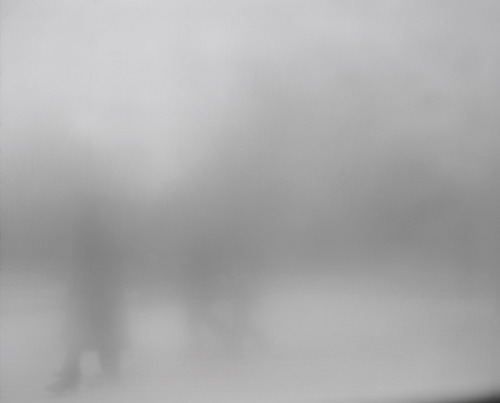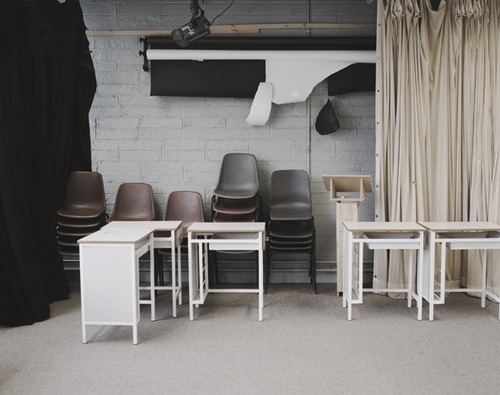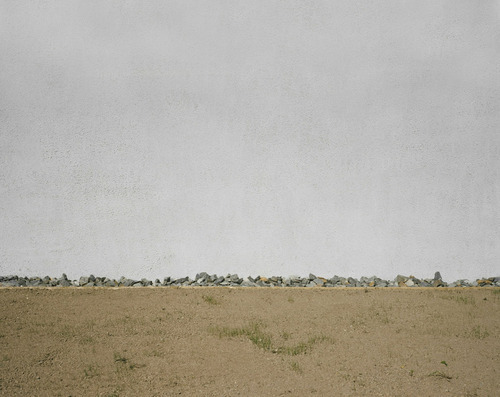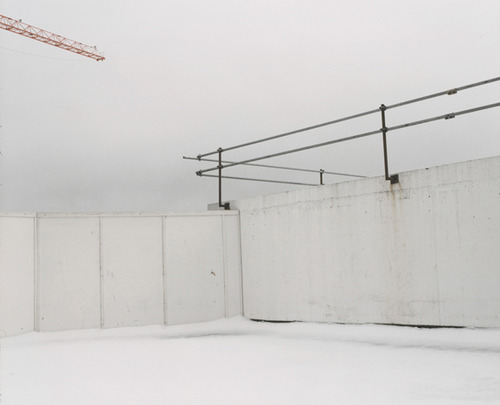BY STEVE BISSON
1. Can you briefly describe your career - how did you get to St Kevin’s College of Further Education, Dublin? What directed you towards a teaching career?
My teaching career began in 2006. I never really gave it serious thought until the opportunity arose by chance. At the time I was working in a Dublin photo shop and continued to do so two years into my teaching role. So, a double life of sorts to begin - switching from delivering lectures, tutoring in the morning, to being subservient in the afternoon. Making ends meet. I was fortunate enough to have licence to do whatever I wanted within a three hour teaching remit. A lot of hit and miss material and modes of delivery at first, but I learned the craft of teaching and found my identity as an educator, by just being thrown into it - without prior experience or formal training. It was supposed to be a short-term arrangement. But, once students started to respond, I suppose, to what I could offer, things began to change. Certainly the course began to change, from 10-12 students in 2007 to becoming one which is quiet recognized within the hierarchy of photographic education in Ireland. Currently we have close to 70 students on our books, many of whom progress directly to 2nd year of degree programmes, many strait into the world of work – a high standard and a high expectation for a course at our modest level.

© Martin Cregg from the series ‘Suspended State’
2. Could you introduce us to photography and educational activities/programme at St Kevin’s College? What are the main challenges you face in teaching?
We are part of a community college, of course, not a University or Technical College. We deliver a Level 6 Diploma as our highest award (Level 8 is equivalent to a degree) within a very tight budget and a lot of resource limitations. However, it’s the only course of its kind in this country and we pride ourselves on its uniqueness. Certainly I have grown to love and respect the characteristics and the ethos of this level of education. It’s cheap, democratic, inclusive and there is real sense of honesty and integrity in what we try to achieve. We educate a very broad demographic of student, at a very diverse level of skill and educational background. The staff are generous, passionate, approachable and very hard working professionals, who genuinely, by and large, put the interests of the course and the students first. We have built this photography course together, from very small beginnings, and work beyond vocation to keep it alive, to keep it running - day after day, year after year. It’s a big wrestle. Generally, our level of education (in Ireland we call it PLC - Post Leaving Certificate), gets the widest social profiles of all adult education or third level institutions in the country. We link with young adult education centres, unemployment centres, outreach programmes and high schools as well as, in our context, camera clubs and existing colleges that teach photographic modules. We draw a lot of retirees and, recently, a lot of people who are hit by the circumstances of the recession in Ireland. Essentially, we facilitate people from all walks of life, of all ages – 17 to 70 and beyond. With such a broad demographic, we are always conscious of each individual’s background and the welfare of our students is paramount for us.

© Martin Cregg from the series ‘Fading Landscape’
To maintain the course is one challenge, but to create an atmosphere of trust and compassion where education is a condition of growing, maturing, at times personal rebuilding, is another. Teaching photography, consequently, is only half the job. At our level of education, we need to be conscious of responsibilities that are beyond delivering information or simply instructing. As a teacher, you are expected to act as a constructive guide for people, to offer a map through the wilderness if necessary - not just professionally or creatively, but personally. The pastoral care element to our work can be all-encompassing. In art education, in any form of education, however, it can prove to be indispensable. Our obligation to get to know our students, to offer ongoing counsel and pastoral support has, without question, contributed significantly to the strength and character of work produced at St Kevin’s College over the last number of years. Much of our graduate work has explored issues of identity, gender, family and home, for example. Bringing intimate worlds, personal stories, real life experiences into the public realm has become a feature of our end of year shows. The work has, at times, been a visual expression of some very sensitive personal experiences or internal conditions. The personality of the end of year shows are perhaps a consequence of the environment we establish, coupled with the teaching formula we set in place, from the beginning of the course itself - the little building bricks embedded on the first days or weeks or months of the term.

© Martin Cregg from the series ‘Fading Landscape’
It may be an unusual strategy for what might be termed a “beginners” course, and certainly we are a beginner’s course, but in my own role over the last number of years, I have prioritized what could be called ‘meaningful’ imagery over any technical or skills aspects from the very start. I believe that students need to begin their journey by viewing photography as a way of exploring and expressing important issues relating to their own life - to see photography as a way to connect with social life, the immediate world and with the self. Photography is, of course, also as a way to question all of these things. The issue of technique and skill will always follow. But better to explore what is really worth looking at than executing perfectly yet another image of a bridge, or a plant or a pet as the only intention. Granted, when presented with images with these or similar characteristics, I would never allow my opinions to get in the way of a students development at such an early stage. I am conscious of the sensitivities of people and the necessity to be appropriately constructive and encouraging - especially at the foundation level.

© Martin Cregg from the series ‘Suspended State’
The fundamental approach of my own area of the course is, however, first and foremost about shaking off preconceptions people have about photography, its role, its uses, its purpose. Regardless of the fact that we are under the remit of a foundation skill-based level course, in my experience, people who are introduced to the photography programme at St Kevin’s almost immediately begin to see a new value for photography - as something that can alter the way they see and feel and experience the world. So our exploration of the image world demands a level of critical thinking and discussion surrounding a broad spectrum of issues that are social, cultural, historical, psychological, emotional meanings. Sometimes the use of imagery and the conversations that they encourage, can also open up a pathway to other issues which some people may never get the opportunity to discuss or disclose in any other situation or environment. With the development of the students own work, I employ several photo-elicitation techniques, encourage text and prompt students to discuss their lives, their perceptions and the human condition in general. They are encouraged to not be afraid or ashamed about discussing anything openly within the environment of the classroom. Students own images become almost like stimulus cards in this process. My role is often to facilitate discussions and mediate the conversations. The teaching techniques of Wendy Ewald and Nathan Lyons, for example, have been very influential in how I approach the profession. The photography class can and has become a platform for students to share and understand broad experiences of social and mental life. In the end isn’t that a key component of what makes education so important.

© Martin Cregg from the series ‘The Photo Course’
Consequently, the craft of balancing the teaching of a visual art with what you could call a support group sensibility can absolutely offer a secure grounding for students to explore and navigate the world of photography. My suspicion is that this balancing act is necessary sometimes, in order to pull strong meaningful work out of insecure self-doubting people. As an educator, I have seen transformations that have astonished me. Many of my students over the last number of years have been so brave in what they create and what they disclose through their work – about who they are, about what they have experienced, about the conditions of life. Not that every student is provoked into exploring their emotional side of course. Far from it. Students always have licence to develop whatever type of practice suits their personality - be it commercial, documentary, fashion, etc. But, my experience of working in St Kevin’s has reinforced my own conviction about how art or expression, in any form, can be a cathartic and a life-affirming process. Certainly, confronting any issue face-on with a camera can be a very therapeutic and empowering practice. Time after time, with many of the successes of our course, I have found this to be the case. My experience has also reinforced my own personal faith in the principals of education, this level of education, and what it can offer people - regardless of background or age or personal limitations. I am very proud of who we are and what we do.
3. In 2011 yours ‘Photo Course’ project was short-listed for the FOAM Talent Call. Tell us about it.
Photo Course is really about two things - the building itself and about my own peculiar sensibilities. At first it was a May project - I only took photos on the last day of college, when I was little more sensitive to aspects of the building that, in the normal daily grind of working life, would be overlooked, or seem insignificant. It’s at those moments in our final days, when the sound of the clock seems amplified, that I found I could focus and disappear into the fabric of the building. In a tactile way, I looked for some energetic imprints from teaching and learning photography against the ‘dead wood’ of the empty institutional environment. I set out to explore how the educating space is shaped through our mental and physical interactions - how we develop and perform ideas, day upon day, year upon year and to amplify the relationships between photographic discourse, practice and it’s environment.

© Martin Cregg from the series ‘The Photo Course’
The work is also about loss, I think. I began doing this project out of an emotional impulse. Teaching can be all-consuming if you allow it to be. One can get devoured by the workload and the stress, the impatience and ambition, the uncertainties and emotions of others. In the end, I think there must be an acceptance that there is and should be nothing in return. Perhaps this is where the sense of emptiness comes from throughout the work. Certainly, I find that at times my job pushes me into a very lonely place. It is part of the cyclical and transitional condition of the job.The work represents some aspect of these feelings, these cycles and transitions, from one year to the next - a certain reality of transient, ephemeral relationships which are built year upon year after year between myself and my students in this building that has become such an important part of my own life.
4. Landscape is a central topic of the work ‘Midlands’. Many recognize in photography a documentary ambition as happened before with social issues. However, often there is an attempt to record the presence of the photographer. The photographer somehow feels the need to build his/her landscape. You wrote that Midlands are ‘under constant construction and re-definition’. So is there something utopian in all this? A humanist, and perhaps functional distortion of reality.
Utopian, of course. The concept of the ‘midlands’ project was prompted by a map drawn up by the National Spatial Strategy in 2002 – a grand plan for Ireland, which, on paper, sought to reshape and reconstruct a number of key regions on the island of Ireland as a whole. I was immediately drawn to it. The ‘Midlands’ – a disputed region, in many ways, was allocated a number of major strategic infrastructural projects designed to transform the region. The initiative centred on a massive plan to introduce an inter-triangulation of “gateways” and “Hubs” in the central part of the Country and was designed to kick-start an economic revival and encourage a dynamic regeneration and re-population of what was seen as a potential core area of the country. Over a ten year period my ‘Midlands’ project explored and mapped the physical transitions which are as a direct consequence of the promise of the National Spatial Strategy, and the physical effects of the failures of this plan - from 2004, until it was finally abandoned in 2013. Throughout the cycles of economic and cultural change, I set out to represent the changes in and on the landscape - from the promise of progress, through the frustrations of stagnation and subsequently to the anguish of collapse. So, cyclical processes of erasure, construction, abandonment and decay became my main focus. While the work represents topographic alterations which were both subtle and monumental, minute and large scale over this period of time, it also represents the porous nature of the imagined borders of the region itself, questioning the very concept of what the ‘Midlands’ is – an undetermined geographical entity, under constant construction and re-definition.

© Martin Cregg from the series ‘Midlands’
‘Midlands’ is taking the form of a publication, due for release in early 2015. It will mark 10 years of work. In terms of photography, I am always drawn to projects which, hopefully, have an enduring value – address something of my time, consider a historical aspect, challenge me to explore the medium itself. But, with midlands, I feel I have offered a little contribution to the social and cultural reality of contemporary Ireland and am happy that the work can be considered and appreciated in a wide variety of contexts from the world of sociology and History to the world of Art.

© Martin Cregg from the series ‘Midlands’
In terms of your question/comment about the ‘presence of the photographer’. One of the key features of this work is the relationship between the grand plans and maps which appear on paper and the notion of being a microscopic observer in the real world. Strangely, I was always conscious of this as I photographed. On a personal note, this on-going ritual of photographing these transforming landscapes has become an important feature of my life really. The project started when I was a student in 2002 and has taken me right up to my late 30s. It has always offered me a sense of purpose and vocation. I have always carried with me a strong sense of mission and a determined commitment to documenting some aspect of my time. It also charts my own personal development as a photographer. There is a naivety at the start, references to some practices I was interested in and applied to my practice as I moved forward - such as Land Art, Minimalism, Conceptual Art, etc. Further, towards the middle of the work there is perhaps a more mature grasp of the practice and of representation. For me, I can even identify some turning points in my practice. The work was and is my education – a self directed commission, a personal journey, a growth of ideas and approaches which helped me to form my own identity as a photographer. But, it is an ongoing process. In a way one never stops being a student of the medium.

© Martin Cregg from the series ‘Midlands’
5. You have recently started an interesting series ‘re.call’. It reminds us of the meaning of imperfections. Kind of warning to the hyperreal age, such as the digital and technological one…
Not a warning. I hope the work doesn’t come across as a pathos piece about the loss of analogue photography. It’s anything but. I think it’s just another little contribution to the memory of a particular popular use or mode of photographic practice. Its something that has disappeared from the landscape of photography – it’s the loss of a ‘failure’, maybe (of analog), a loss of a technical frustration of the practice. I worked for many years in photo labs. All of which are now closed, as far as I know. In one place, we worked the late shift where bags and bags of disposable cameras from the pharmacies around Dublin would flood in to us during the evening hours. Quality control was a necessary role then. It was exhausting trying to spot and recognize the gathering imperfections that became visible on each film reel only after they were printed. Re-call has a nice double meaning. On the one hand to recall is part of the act of memory, on the other it is a term used regularly in the line of production for faulty products. I gathered and collected all sorts of weird and wonderful artefacts from those days. Finally, I feel I may have some ideas about how to give all this material some shape and some form. I’m considering a book at the moment.
6. Is there any show you’ve seen recently that you find inspiring? Why?
I don’t get to travel much these days, so have limited first hand experience of exhibition work. But the Sochi Project in Dublin this summer was lovely. Great to see such incredible work utilizing such a wonderful new venue. The work itself is superb and the PhotoIreland Festival which brought the work here, has made a good contribution to Irish life. I also got to see the installation of Lorenzo Vitturi's work at the photographers gallery in London this summer. It was very exciting!

© Martin Cregg from the series ‘Suspended State’
7. Three books of photography that you recommend? Why?
Tough. Well, ‘The Pond’ by John Gossage is one I recommend in regards to editing, and flow of imagery. It’s size. It’s pretty much a perfect book of photography. Its joyful to navigate and engrossing work. Everything is so well considered, really ahead of its time in terms of how photography can effectively translate into a book form. A lot of crafty self made publications irritate me, I must confess - especially ones which champion the quirkier design aspects over the maturity of subject. I tend to gravitate towards works which have, maybe, modest and enduring qualities. I’m drawn to something where I can feel the labour and struggle of the author to explore and produce the work. I am quiet stubborn in many ways when it comes to what I really value in photography. Recently ‘The Canaries’ by Thilde Jensen caught my attention. Mikael Subotzy in Collaboration with Patrick Waterhouse have an incredible exploration of ‘Ponte City’, Jonannesburg. Both have a lot to look at, a lot of information. Both feel really complete. The form they have taken is also appropriate to the work. I admire both works as I admire anybody who puts their heart and soul into producing and contributing something to the photographic world. However, just some additional mentions, books such as Mark Cohen’s ‘Dark Knees’, or Robyn Maddock ‘3’ and anything by Daido Moriyama always make me want to take pictures. They have an effect. It’s what I look for - something that inspires and motivates me to make work.
© Martin Cregg | Urbanautica